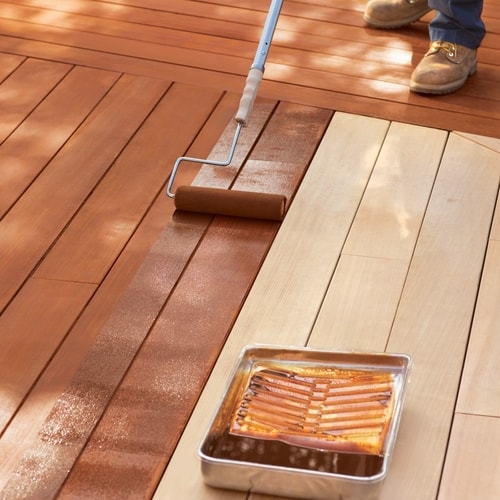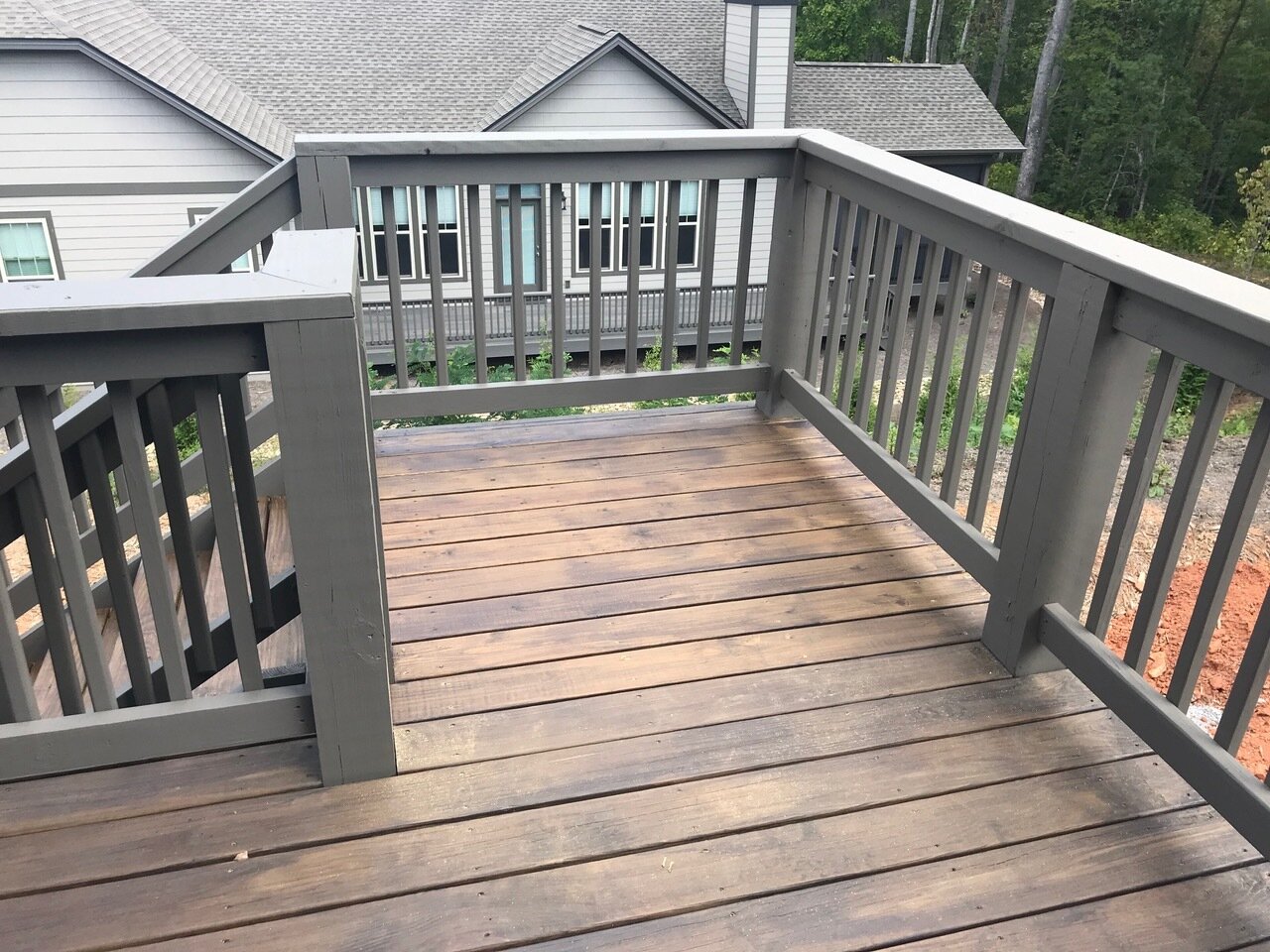Deck Staining Quality: Nourishing Your Exterior Retreat
Deck Staining Quality: Nourishing Your Exterior Retreat
Blog Article
Picking the Right Stain for Your Fencing: Tips and Factors To Consider
When it involves maintaining and enhancing the appearance of your fence, picking the appropriate tarnish is vital. With a wide range of options offered, it can be overwhelming to identify which tarnish will best fit your requirements. This overview will give you with suggestions and factors to consider to help you make an educated choice. We will discover the different types of fencing spots, variables to think about before selecting a discolor, suggestions for preparing your fence for staining, and the differences in between water-based and oil-based spots. Additionally, we will explore picking the appropriate stain shade to complement your fence and boost your outdoor area. By complying with these guidelines, you can make sure that your fencing remains protected and aesthetically pleasing for years to find.
Comprehending Different Kinds Of Fencing Discolorations

On the other hand, water-based spots are made from acrylic or latex and provide a more subtle shade to the wood. They create a safety movie externally of the wood, stopping dampness from seeping in and shielding versus UV damage. Water-based spots are easier to tidy up and have a quicker drying time compared to oil-based stains. They are likewise much less most likely to crack or discolor in time.
Choosing in between water-based and oil-based spots relies on different factors, including personal preference, the wanted appearance, and the degree of maintenance required. Oil-based stains are suggested for surround high-traffic locations or those frequently exposed to severe weather condition problems. fence staining. Water-based spots, on the other hand, are a popular selection for fence domestic areas where look and convenience of use are essential
Recognizing the distinctions in between oil-based and water-based discolorations assists house owners make an informed choice when selecting the appropriate stain for their fencing. Thinking about the particular needs of the fence, such as its area, direct exposure to sunlight, and wanted aesthetic, will certainly guarantee that the chosen discolor offers lasting defense and enhances the overall elegance of the fencing.
Variables to Think About Prior To Choosing a Stain

An additional factor to take into consideration is the kind of timber your fencing is made of. Various sorts of wood absorb spots differently, leading to differing degrees of shade strength and sturdiness. For instance, softwoods like ache might need more regular discoloration contrasted to hardwoods like cedar or redwood. In addition, particular woods may be much more vulnerable to issues like rot or insect infestation, which might affect the selection of tarnish to maintain the fencing and secure.
The climate and climate conditions in your location need to likewise be thought about. If you stay in a location with extreme winters months or high humidity, you may need a tarnish that offers added protection against wetness and UV rays. Furthermore, if your fencing is revealed to route sunshine for extended periods, a tarnish with UV inhibitors can aid protect against fading and discoloration.
Finally, it's crucial to consider your desired visual. Various discolorations use different colors and coatings, enabling you to tailor the look of your fence (deck staining). Take into consideration the general design and style of your property, as well as any kind of regional laws or home owner association guidelines that might determine the acceptable discolor colors
Tips for Preparing Your Fence for Discoloration
To prepare your fence for staining, start by extensively cleaning up the surface making use of a mild cleaning agent and a pressure washer or scrub brush. Cleaning the fencing is a vital step as it removes dirt, crud, and any type of previous layers that might hinder the staining procedure. Begin by moistening the fence with water and afterwards apply a moderate cleaning agent utilizing a scrub brush or a pressure washer with a low-pressure setup. Scrub the surface area gently, paying additional interest to locations with persistent spots or mold. Rinse the fence thoroughly with tidy water to eliminate all traces of cleaning agent.
This action is crucial as discoloring a moist or damp surface can lead to inadequate attachment and an irregular surface. Guarantee that the fence is totally dry prior to proceeding with the discoloration procedure.
Prior to discoloration, check the fencing for any kind of damages, such as loosened boards or nails. Repair any kind of problems to make sure that the fencing is structurally sound. Additionally, take into consideration applying a timber conditioner or brightener to the surface area. This item aids to open the timber pores, enabling the discolor to pass through better and uniformly.

Comparing Oil-Based and Water-Based Spots
When picking a stain for your fencing, it is necessary to compare the qualities and benefits of oil-based and water-based spots. Both types of stains have their very own benefits and factors to consider, so it is important to recognize the distinctions in between them.
Oil-based spots are understood for their durability and resistance to damage. They pass through deeply into the wood, giving excellent defense against the components. They likewise improve the all-natural charm of the timber by highlighting its grain and appearance. In addition, oil-based spots have a tendency to last longer than water-based spots, making them a popular choice for fencings.
On the other hand, water-based spots are extra ecologically pleasant and easier to cleanse up. They have a reduced VOC (unstable natural substance) web content, which implies they release less unsafe fumes right into the air. Water-based stains also dry faster, enabling for a quicker application and less downtime. They may not provide the exact same degree of protection as oil-based stains, specifically in extreme weather problems.
Inevitably, the option between water-based and oil-based discolorations depends on your certain requirements and choices. Consider variables such as sturdiness, environmental impact, and convenience of application when making your decision. Consulting with an expert or looking for suggestions from professionals can also aid guarantee that you select the right tarnish for your fence.
Picking the Right Discoloration Shade for Your Fencing
The choice of an ideal discolor color for your fencing is an essential aspect of boosting its visual charm and matching the general design of your exterior area (fence staining nashville tn). The right stain shade can transform a plain, regular fencing into a striking focal point that includes depth and character to your home
When choosing a discolor shade for view publisher site your fencing, it is necessary to consider the design and style of your home. Natural tones such as browns and neutrals can produce a cozy and inviting appearance if you have a classic or typical style home. On the various other hand, if you have a modern or modern-day home, you might consider choosing vibrant and vivid shades that make a statement.
One more variable to take into consideration is the natural environments of your residential property. If you have a great deal of greenery, a stain shade that enhances the natural landscape, such as greens or crimsons, can create a unified and natural appearance.
Additionally, it deserves thinking about the upkeep needed for different stain colors. Lighter colors often tend to show dust and use more easily, while darker colors can hide blemishes and require less frequent touch-ups.
Inevitably, the selection of stain color for your fencing should reflect your individual style and choices - deck staining. Put in the time to explore different alternatives and speak with with professionals if needed, to guarantee that you pick the ideal stain shade that improves the elegance and appeal of your fencing
Verdict
Finally, when it involves choosing the best stain for your fencing, it is essential to recognize the different sorts of spots available and consider elements such as longevity and wanted appearance. Preparing the fence properly prior to discoloration is crucial for attaining optimum results. Furthermore, contrasting oil-based and water-based stains can assist figure out the very best alternative for your certain demands. Finally, picking the right stain color can boost the total visual appeals of your fence.
We will check out the various kinds of fencing stains, aspects to think about before selecting a tarnish, suggestions for preparing your fence for discoloration, and the differences in between water-based and oil-based stains.Separating in between water-based and oil-based discolorations is critical when understanding various kinds of fencing spots. Water-based spots are much easier to cleanse up and have a much faster drying time compared to oil-based stains. In addition, oil-based stains tend to last longer than water-based discolorations, making them a prominent selection for fencings.
In conclusion, when it comes to picking the ideal discolor for your fence, it is vital to understand the different kinds of spots offered and take into consideration factors such as longevity and desired look.
Report this page